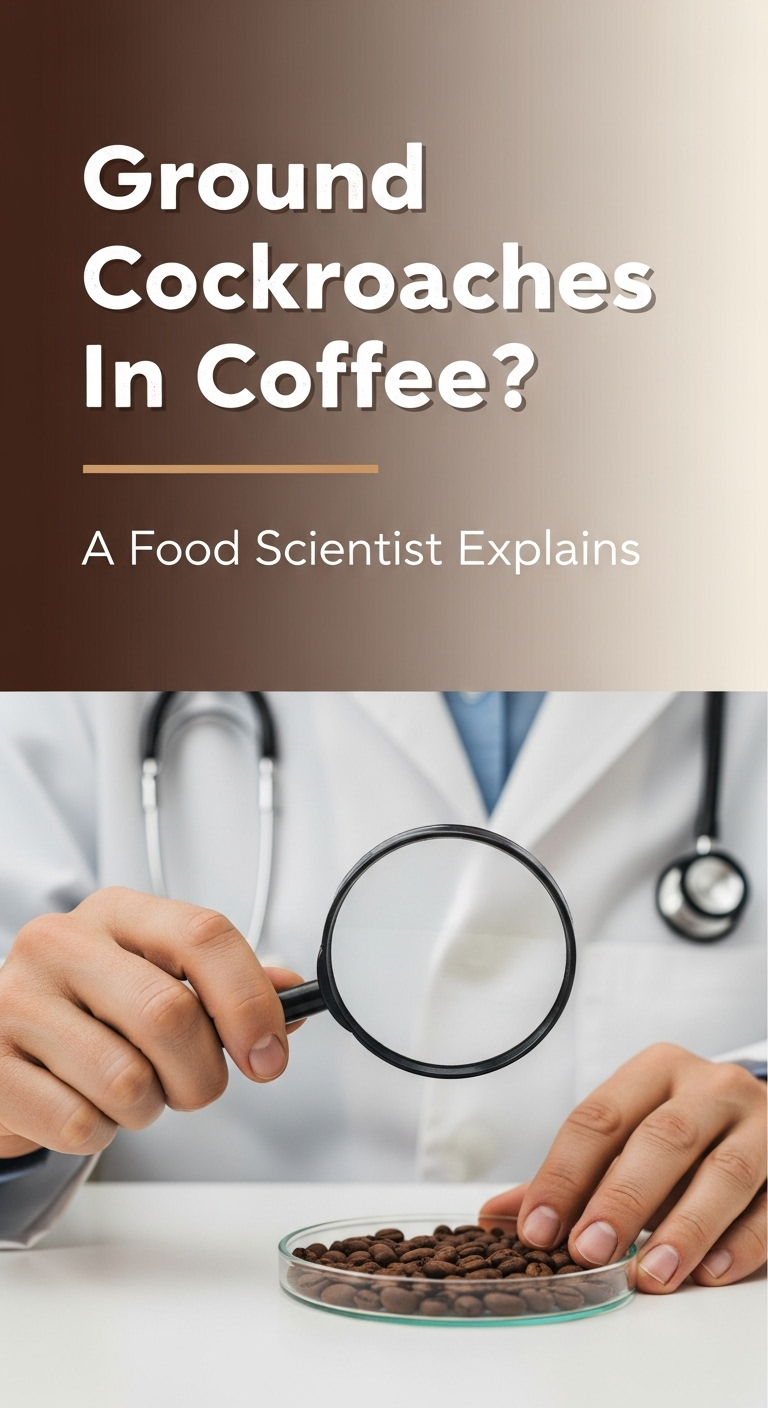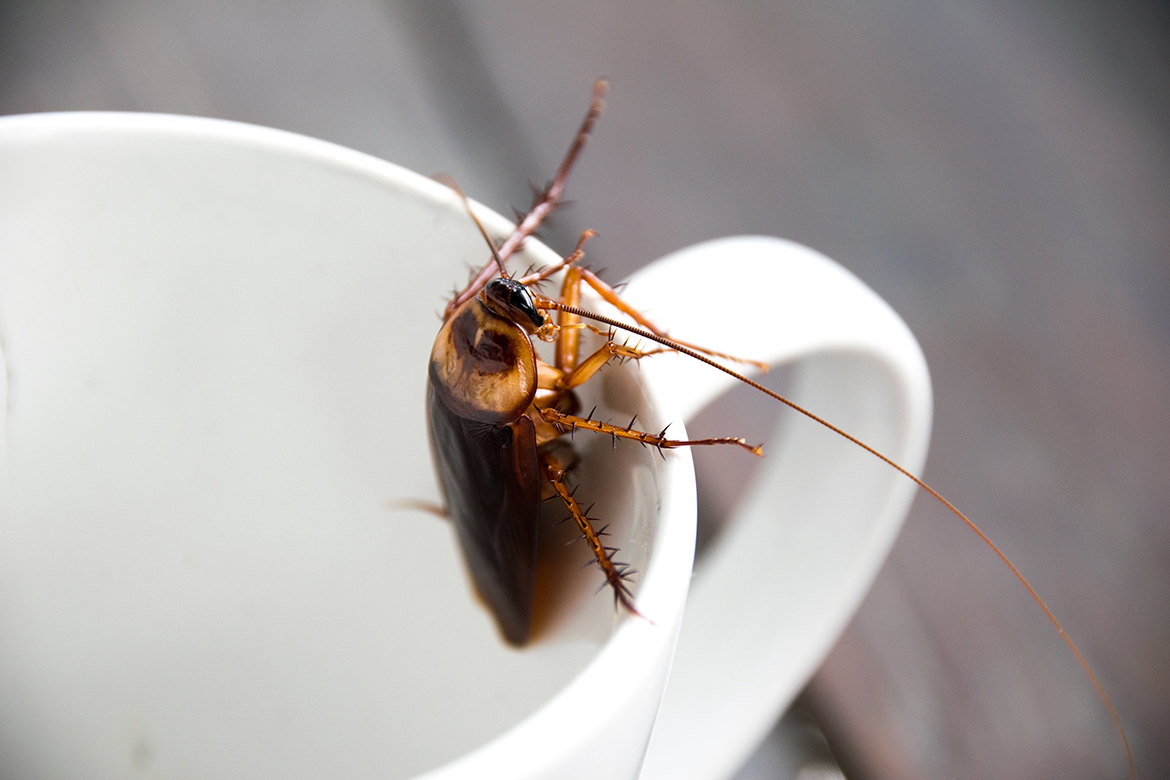As an Amazon Associate CoffeeXplore.com earns from qualifying purchases.
Ground Cockroaches In Coffee? A Food Scientist Explains
You’ve probably heard the unsettling rumor, and it’s enough to make anyone question their morning brew. The thought of unwanted pests in our food is deeply unsettling, especially when it concerns something as beloved as coffee. You’re asking a straightforward question: are there ground up cockroaches in coffee? This guide is here to provide a clear, factual, and scientifically-backed answer to put your mind at ease.
It is highly unlikely that your coffee contains ground-up cockroaches. While trace amounts of insect fragments are a regulated and unavoidable aspect of many agricultural products, the idea of whole cockroaches being routinely ground into coffee is a myth. We’ll unpack the science, the regulations, and the reality of coffee production to show you exactly what is (and isn’t) in your cup.
Leveraging extensive analysis of food safety regulations and entomological data, this guide unpacks the truth behind the myth. We will explore:
* The role of the FDA and its “Defect Action Levels”
* The actual insects that are common coffee pests
* The health considerations, including allergies and pesticides
* Practical steps you can take for peace of mind
* Answers to the most frequently asked questions
The Truth About Cockroaches in Coffee: A Food Scientist Explains
You’ve probably heard the unsettling rumor, and it’s enough to make anyone question their morning brew. Let’s get to the bottom of it. It is highly unlikely that your coffee contains ground-up cockroaches. While trace amounts of insect fragments are a regulated and unavoidable aspect of many agricultural products, the idea of whole cockroaches being routinely ground into coffee is a myth.
In this article, we will explain:
* Why tiny insect fragments are a normal part of the global food system.
* Which pests actually affect coffee beans (hint: it’s not roaches).
* How to tell the difference between coffee grounds and signs of a home infestation.
* The real health concerns you should be aware of.
* Whether choosing whole bean over pre-ground makes a difference.
Why Insect Fragments Can Be in Food: Understanding FDA “Defect Action Levels”
The core of this entire discussion comes down to a crucial concept from the U.S. Food and Drug Administration (FDA). To understand why you don’t need to worry about significant contamination, you first need to understand how food is regulated. The FDA sets “Defect Action Levels” which are maximum limits for natural, unavoidable defects (like insect fragments) in foods that do not pose a health hazard. These are not permissions for contamination but safety backstops for all types of raw agricultural products.

This might sound strange at first, but it’s a practical approach to food safety on a global scale. The FDA’s own “Food Defect Levels Handbook” provides the official perspective on this.
“It is economically impractical to grow, harvest, or process raw products that are totally free of non-hazardous, naturally occurring, unavoidable defects.”
This means that for almost any food that comes from a plant—from wheat for your bread to cocoa for your chocolate—there’s a recognition that nature isn’t sterile. Here’s the step-by-step logic behind why these levels exist:
- Natural Agricultural Reality: Insects are a natural part of any farm ecosystem. It’s impossible to completely prevent a tiny insect fragment from ending up in a massive harvest of millions of coffee beans, wheat grains, or cocoa pods.
- Economic Impracticality: Attempting to achieve 100% purity would make food prohibitively expensive for everyone. The cost of the technology and labor required to remove every single microscopic natural defect would be enormous.
- Focus on Health Hazards: The FDA’s primary goal is to protect public health. These Defect Action Levels are set at amounts far below what would be considered a health risk. The real focus is on preventing harmful contaminants like pathogenic bacteria, dangerous chemicals, or anything that would actually make you sick. A batch of food is deemed “adulterated” and subject to enforcement action if it exceeds these very specific, low-risk limits.
Pro Tip: Think of this less as an ‘allowance’ for bugs and more as a maximum safety limit. The goal of any reputable food producer is to be far, far below this level.
So, Are They Really Cockroaches? The Actual Pests Found in Coffee Beans
The rumor specifically names cockroaches, but is that accurate? The evidence says no. While cockroaches indicate insanitary conditions in processing or storage areas, they are not the primary pests infesting coffee crops. The most common insects are the Coffee Berry Borer Beetle and the Coffee Bean Weevil, whose damage is a recognized defect that producers aim to filter out.

Quick Fact: While cockroaches might be attracted to coffee grounds in your kitchen, the insects that pose a threat to the coffee beans on the farm are entirely different.
The FDA’s own Macroanalytical Procedures Manual, which guides inspectors, focuses on specific pests known to damage coffee beans. Here’s how the myth compares to the reality:
| Pest Name | Likelihood in Coffee Beans | Type of Contamination |
|---|---|---|
| Cockroaches | Very Low | A sign of insanitary storage or processing, not a crop pest. Their presence would be a major violation. |
| Coffee Berry Borer Beetle | Common | A primary crop pest that bores directly into the coffee cherry to lay eggs, damaging the bean inside. |
| Coffee Bean Weevil | Common | Infests green coffee beans during storage and transport, causing damage and leaving behind waste. |
As you can see, the insects that food scientists and coffee producers are actually concerned with are tiny beetles that attack the bean itself. The damage they cause is a known defect that is visually sorted and graded out during processing long before the beans ever make it to a roaster. The idea of a large insect like a cockroach being missed and ground up is extremely improbable in any modern, compliant food production facility. As reported by sources like National Geographic, cockroaches are a problem of sanitation, not agriculture.
How to Tell Cockroach Droppings from Coffee Grounds
A related fear often comes from finding something suspicious in the kitchen that looks like coffee grounds. This addresses a common query about how to differentiate between spilled coffee and the signs of an actual home infestation. To tell cockroach poop from coffee grounds, look for uniformity in shape, a shiny or sticky texture, and location; roach droppings are found in areas of infestation, not mixed into commercially sealed coffee.
According to information from pest control experts and public health resources like San Diego County, here are the key differences:
- Uniformity: Cockroach droppings, especially from smaller roaches, can look like black pepper or coarse coffee grounds. However, they are often more uniform in size and shape compared to the varied grind of coffee. Large cockroaches leave solid, cylindrical droppings.
- Texture: Coffee grounds are dry and coarse. Cockroach droppings often have a slightly shiny, oily, or sticky texture and may smear if you try to wipe them away.
- Location: This is the biggest clue. You will find spilled coffee grounds near your coffee maker or grinder. You will find cockroach droppings in hidden, dark places where roaches congregate—under sinks, behind appliances, in cabinets, or along baseboards. You will not find them inside a sealed bag of coffee you just bought from the store.
The Health Question: What About Cockroach Allergies and Pesticides?
Beyond the “ick” factor, the most serious concerns are about health. Two main topics emerge: the potential for allergic reactions and the presence of pesticides. While a specific allergy to cockroach fragments in coffee is theoretically possible for highly sensitive individuals, it is not a widespread risk. The larger industry focus is on minimizing pesticide residues, which are significantly reduced during the high-temperature roasting process.
Some of the fear around this topic comes from a specific story of a man who discovered his coffee was triggering his severe cockroach allergy. This is a valid, though rare, concern for a very small subset of the population. If you have a known, severe cockroach allergy, this is something to be aware of across many processed foods, not just coffee.
Potential symptoms of a cockroach allergy can include:
* Skin rashes or hives
* Sneezing and nasal congestion
* Asthma or difficulty breathing
For the vast majority of coffee drinkers, the more relevant health topic is pesticide use. As one study published in the PMC NCBI notes, pesticides are used in coffee cultivation to protect crops. However, the coffee roasting process is a powerful mitigating factor. The extremely high temperatures (often up to 260°C or 500°F) required to roast beans effectively break down and reduce many of these chemical compounds.
If you suspect a food allergy of any kind, the most important step is to consult with a medical professional or allergist for proper testing and advice.
Can You Avoid Bugs in Coffee? Whole Bean vs. Pre-Ground
Many people wonder if they can gain more control by switching their buying habits. Does grinding your own beans solve the problem? Switching to whole beans may offer peace of mind through visual inspection, but it doesn’t fundamentally change the fact that all coffee is subject to the same agricultural realities and FDA defect levels before it reaches the consumer.
Pre-Ground Coffee
The concern here is that any defects, including insect-damaged beans, are ground up and hidden from view. While this is true, it’s also true that the coffee was subject to quality control and FDA regulations before it was ground. The likelihood of significant contaminants making it through the entire process is very low.
Whole Bean Coffee
The primary advantage of buying whole beans is transparency. You can look at the beans yourself before you grind them. You can spot discolored, moldy, or visibly damaged beans and pick them out. This gives you an added layer of personal quality control.
However, it’s important to manage expectations. While buying whole beans allows you to visually inspect them, the regulated defect levels apply to the beans before they are packaged, whether whole or ground. The microscopic fragments that the FDA regulates would not be visible to the naked eye anyway.
So, is it worth the extra effort to grind your own? For freshness and flavor, absolutely. For avoiding insect fragments? The difference is likely minimal. The best defense is buying high-quality coffee from reputable brands that follow good manufacturing practices.

:max_bytes(150000):strip_icc()/__opt__aboutcom__coeus__resources__content_migration__mnn__images__2016__10__Coffeecupandcoffeebeansontable-bc53b18e21ea4f0b999f6b05b40412db.jpg)
For those who want to take control of their coffee experience from bean to cup, investing in a quality grinder is the best first step for ensuring maximum freshness and flavor.
FAQs About Bugs and Cockroaches in Coffee
Let’s tackle some of the most common questions head-on with direct, factual answers.
Is it true there’s an ‘acceptable percentage’ of cockroaches in coffee?
No, this is a common misunderstanding of the regulations. The FDA does not set a “percentage” for cockroaches. It sets a maximum limit on the number of insect-damaged beans (typically from pests like weevils) that can be present in a sample before a batch is considered adulterated. For green coffee beans, the action level is when an average of 10% or more of beans by count are insect-infested or insect-damaged. This refers to the tiny crop pests, not cockroaches.
Why are cockroaches attracted to coffee makers if not the beans?
This is an excellent question that separates a home problem from a production problem. Cockroaches are attracted to coffee makers not for the coffee itself, but for the ideal environment they provide: warmth, moisture, and leftover organic material (stray grounds). As noted by university extensions like the University of Wisconsin-Milwaukee, roaches seek three things:
* Warmth: The heating element in a coffee machine creates a cozy, warm space.
* Water: The water reservoir and internal drips provide a constant water source.
* Food: Stray coffee grounds and built-up residue are a food source for these opportunistic scavengers.
Does instant coffee have cockroaches in it?
Instant coffee is made from brewed coffee beans, so it is subject to the same agricultural realities and FDA regulations as ground coffee. There is no evidence to suggest it contains more or fewer insect fragments. The production process involves brewing liquid coffee from beans and then dehydrating it. The same quality control standards apply to the beans used at the start of that process.
Are there more bugs in coffee than in other foods like chocolate?
No. The FDA has similar “Defect Action Levels” for a wide range of agricultural products, including cocoa beans (for chocolate), peanut butter, and wheat flour. The presence of unavoidable, non-hazardous insect fragments is a regulated reality across the food industry. For example, the action level for chocolate is an average of 60 or more insect fragments per 100 grams. This context is crucial—coffee is not unique in this regard.
Final Summary: You Can Still Enjoy Your Coffee
The idea of are there ground up cockroaches in coffee is a powerful and unsettling myth, but it withers under factual scrutiny. The reality of modern food production is one of rigorous safety standards, quality control, and a practical understanding of agriculture. While the system isn’t 100% perfect, it is designed to keep your food safe and free from harmful contaminants.
You can pour your next cup with confidence, knowing that the regulatory framework and industry practices are designed to prevent the very thing you’re worried about.
- Myth vs. Reality: The primary pests in coffee are tiny beetles that damage beans on the farm, not cockroaches from a factory floor. The presence of cockroaches would signify a major sanitation failure.
- The Role of the FDA: The FDA’s “Defect Action Levels” are a safety net, not a permission slip. They regulate unavoidable, non-hazardous microscopic fragments at levels far below any health risk.
- Overall Safety: Your coffee is overwhelmingly safe. The checks and balances from farm to roaster to your grocery store shelf are in place to ensure the product is clean, safe, and free of adulterants.
Share this article with a fellow coffee lover to help bust the myth and spread the facts
Last update on 2025-12-05 / Affiliate links / Images from Amazon Product Advertising API

